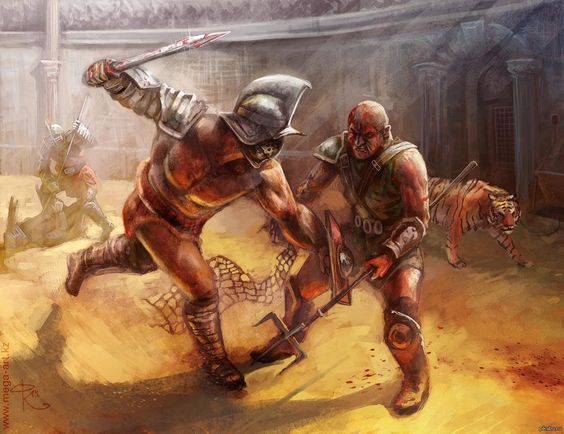One of the most famous and well known of the ancient Roman games, second only to the chariot races in terms of popularity, were the fights of the Gladiatorial Arena, a combination of blood, steal, and strange looking armor. The tradition of the gladiator fights began in Campania, southern Italy, in 264 BCE, to honor the death of Junius Brutus Pera as part of the funeral celebration.1 The sons of Brutus staged a fight between three pairs of gladiators to honor the loss of their father by the spilling of human blood, and to show his importance to the community with a lavish sacrifice.2 The idea of such a spectacle grew in popularity among the people, especially with the aristocrats that could afford to have such a fight at their own funerals. Over the next few centuries, this spectacle became a munus, or obligation to the dead, at aristocratic funerals, and out of them emerged the Gladiator Schools.
Imagine a prison-like environment full of men in peak physical condition training in various techniques of battle, weaponry, and ways to kill opponents. The person that slept next to you in the cells could well be the very man that would end your life, or take a win away from your record, keeping you a slave before the spectators that watched you fight. To win freedom a gladiator-slave would need twenty-five wins under his name, otherwise his status would never change. There were three ways one might become a gladiator: by being a slave sold to the school or as a punishment to the slave; by being captured by the Roman empire as a prisoner; or by being a convicted criminal. On some occasions, one might sell oneself into slavery to a gladiator school for the potential reward money if one earned freedom through fighting, or if one just loved the feel of danger.3 Along with hand to hand combat training, gladiators would also need to train for fighting on horseback, and learn to fight exotic animals from areas outside of Italy, such as lions, elephants, tigers, crocodiles, bulls, and many other animals the Romans thought would make for good combat entertainment.4

With so many spectacles to see, a trip to the arena was a full-day event, fully free for the public to enjoy involving the entire community. Most often, the entire town population would attend the games, closing most of the city. One of the most famous of the arenas was the Flavian Amphitheater, more commonly known as the Colosseum, built to accommodate fifty thousand sitting spectators with room to stand. The floor of the arena was made of wood, covering a network of animal cages with elevators to raise the animals to floor level.5 During the late Roman Republic and even when it began to fall to the monarchy of the Empire, the games became more of a political strategy for elections and less of a sports tradition being sponsored by the government.6 Being the host paying for the full event was the easiest way for your name to reach the Roman citizens. The more games and events one would host, the more your popularity would grow. The people would vote for someone that had the best intentions for Rome, and who else but the man who paid out of their own pocket for a event of the masses. Come election day your odds would be better to be either a part of or move up on the Senate. To not miss out on the chance of gaining popularity among the public, the editor, or host of the days games, would pay for any expense, including food and drinks. By late first century C.E., military generals, senators, and even emperors spent fortunes subsidizing public festivals and games. Appeasing the masses with entertainment and food would come to be known as the strategy “panem et circenses” or “bread and circus.”7
The day would begin with a hunt or fight between the captured exotic animals and the “hunter” inside the arena. For the animals that did not get killed, they would be trained and do tricks in the arenas.8 Then, when that match had concluded, there would be a type of intermission between the fights around noon, but instead of the crowd leaving for a short break, there would be the public execution of a criminal sentenced to death.9 To keep the events interesting, sometimes the execution would involve a creative death, by having the criminal be forced into the arena and hacked to pieces by the fully armed gladiators, or even crucified. Some would be tied to planks of wood to be thrown to the half-starved animals to be devoured.10 Then the closing events would be the Gladiator fights themselves, where broken men would fight to stay alive.

Beginning life in the gladiator schools is what many would call a version of hell on earth to endure. With the gladiators being made up of mostly slaves, prisoners of war, and criminals condemned to fight in the arena, the physical training was the only way to keep going, sleeping inside cells, living in a prison environment with real no companions, because there was no way of knowing who would be your next opponent. Even for the volunteer gladiators, Roman citizens, who entered for the prize money or wanted the danger in their lives, they became nothing less than slaves to their new master. The volunteer had to freely and willingly take the terrifying oath “sacramentum gladiatorum,” or the Sacraments of the Gladiator.11 With this oath, gladiators swore to endure being burned, bound, beaten, and slain by the sword. Then, one would forswear any desire for retribution for the state one would be in, and finally forswear life itself. Using this oath, one would accept the cruel life of a gladiator, live a life of honor, and to refuse to endure any of the sacraments that would be dishonorable, binding oneself with conviction to a master with what is left of ones honor at stake. One would be a loathsome man without dignity and almost without humanity.12 Being a gladiator, one would be treated however the Lanista, the man that buys and looks after the gladiators, sees fit without any recourse to legal appeal. It was also considered disgraceful for any Roman citizen to debase himself and choose to fight in the arena.13
However, not all Romans share this disdain toward gladiators. If one were successful in the bouts, one could become a crowd favorite, like today’s modern athletes.14 These warriors were also seen as a type of sex symbol, because of their perfect physique, being a perfect physical specimen. Many Roman women would even lust after the gladiators for the very same reasons, which explains why Roman citizens, even those from aristocratic families, chose to join the gladiatorial ranks. Taking more of a philosophical approach for citizens joining the gladiatorial ranks, Roman writers such as Seneca addressed the actual visual spectacle seen by the audience. The witnessing of such bravery while facing death in the arena filled with screaming fans. Even when seen as shameful by the Romans to debase yourself, many citizens would still become gladiators.
When it came to actual combat, the gladiators were no pushovers, although the fighting style was designed to be both deadly and visibly appealing for the fans. There were multiple types and categories of gladiator, but there were four main types that had evolved by the early Empire.15 There were the heavily-armed Samnites, or later to be divided as the Hoplomachus, carrying a spear and a small knife with a round shield, and the Secutors, carrying a gladius and large rectangular shield, both outfitted with helpmates and heavy armor. The second is the Thracian, with less armor and wielding a curved knife, the sica, and a small circular shield, the parma. There were Murmillos, identical to the Secutors except for the fish shaped crest on the helmet. Lastly, there were the Retiarius, who lacked all armor and wore a belt with a loincloth, wielding a trident, a fishing net to snare the opponent, and a knife attached to the belt. When chosen for a fight, the editor would rent the gladiators need from the school in preparation for the event. On the day of the games, the gladiators would enter the amphitheater in a colorful parade, drawing lots to decide the parings. Then an official would inspect that all the weaponry was sound and well sharpened. Finally, all gladiators would raise their weapons to the highest-ranking official in the stadium and recite “Morituri te salutamus,” “We who are about to die solute you!” then the savagery of a no rules fight would begin.16

After a savage and bloody battle, many gladiators would have died, and others would surrender, accepting their defeat from the victor. For the ones defeated, they would wait for the editor, or emperor if present, to pass judgment on them, based on how well the gladiator had fought. If the gladiator was to live to fight another day, the editor would point his thumb down, signaling their fate to live. If, however, the editor pointed his thumb to his chest, it symbolized the piercing of a sword through the heart of that gladiator. If a gladiator was able to win back his freedom after twenty-five victories, then for the rest of his life he would be extremely comfortable, with the money given to the newly free man from the Gladiatorial School as reward money. All oaths taken from ones time as a gladiator would be lifted and the Romans citizenship would be returned for those who volunteered. Being once a slave, gladiators would not be allowed to hold any political status or title in the government. Unfortunately for the gladiators loved by the crowd, the school would rig the fights to keep them from leaving the arena. Keeping them trapped as a slave until another gladiator finally ends their life.
- World History Encyclopedia, 2011, s.v. “Classical Traditions.” ↵
- World History Encyclopedia, 2011, s.v. “Classical Traditions.” ↵
- The Greenhaven Encyclopedia of Ancient Rome, 2002, s.v. “Public Games,” by Don Nardo. ↵
- The Greenhaven Encyclopedia of Ancient Rome, 2002, s.v. “Public Games,” by Don Nardo. ↵
- World Eras, 2001, s.v. “Roman Republic Empire, 264 BCE-476 CE,” John T. Kirby. ↵
- The Greenhaven Encyclopedia of Ancient Rome, 2002, s.v. “Public Games,” by Don Nardo. ↵
- The Greenhaven Encyclopedia of Ancient Rome, 2002, s.v. “Public Games,” by Don Nardo. ↵
- World Eras, 2001, s.v. “Roman Republic Empire, 264 BCE-476 CE,” John T. Kirby. ↵
- New Catholic Encyclopedia, 2003, s.v. “Ad Bestias,” by M.R.P. McGuire. ↵
- The Greenhaven Encyclopedia of Ancient Rome, 2002, s.v. “Public Games,” by Don Nardo. ↵
- Carlin A. Barton, “The Scandal of the Arena,” Representations, no. 27 (Summer 1989): 3-6. ↵
- Carlin A. Barton, “The Scandal of the Arena,” Representations, no. 27 (Summer 1989): 3-6. ↵
- World History Encyclopedia, 2011, s.v. “Classical Traditions.” ↵
- World History Encyclopedia, 2011, s.v. “Classical Traditions.” ↵
- The Greenhaven Encyclopedia of Ancient Rome, 2002, s.v. “Public Games,” by Don Nardo. ↵
- The Greenhaven Encyclopedia of Ancient Rome, 2002, s.v. “Public Games,” by Don Nardo. ↵



77 comments
Ian Mcewen
It was interesting to learn about the origins of this bloody sport and how it evolved into something that was common place among both commoners and aristocrats. Like some sports of modern times it is dangerous, though to not the extent with better medicine, understanding of the body, and sports equipment we are able to reduce damages to a minimum among athletes.
Margaret Cavazos
This article was incredibly vivid and descriptive of the life of a gladiator. I liked that the author included descriptions of the different categories of weaponry that the gladiator used, it added an extra layer of depth that made the article even more impressive. I knew that the Romans had a sort of savage joy in seeing others suffer, but I didn’t think it was to the level of gladiators fighting at funerals as a human sacrifice. It is horrifying that gladiators could be spared from death if they were popular fighters, but not allowed to win enough to leave for the same reason. The author also included the political motivations for funding these events, which was another detail that made the article even more layered and interesting!
Aaron Sandoval
This article was really well done, and well researched, the author did a good job od depicting life as a gladiator and the struggles that those who were forced to participate and those that volunteered had to go through. I found it really interesting that there were different categories of combat, and that each category changed the weaponry used. As someone who does not know a lot about the ancient world, I never expected there to be different categories.
Davis Nickle
This article does a fantastic job at highlighting how gladiatorial games were not just a form of entertainment for the Romans, but they were also an incredibly important part of their culture. Throwing games at your expense would be one of the main ways for a Roman politician to gain the love of the people. I also really appreciate how you highlighted the fact that not all gladiators were viewed as sword fodder doomed to die in the arena. Famous gladiators would likely not be allowed to die in the arena because they simply were to popular to the people, and if the peoples favorite gladiator were to die there could be potential outrage or even riots.
Seth Roen
The Romans were bloodthirsty people and enjoyed a good sport. Funny how people say how football or hockey a dangerous and aggressive sport. I am also mentioning the discipline that would go with the training. It’s hard to believe that gladiatorial combat started over a funeral. I can only imagine the thrill and sheer terror that one would experience while amid in the tournament.
Nicholas Robitille
This article was a very interesting one, but it lacked a correct timeline. While this article is true for the beginning of the Roman empire, at around 100 A.D, according to History.com, the state of gladiatorial combat had shifted greatly. Gladiators did not usually fight to the death, as the training, food, and promotion of a gladiator was costly, and for one to simply die after all this training would be a massive waste of time and money. Furthermore, gladiator fighting had later evolved far past a death sport of slaves to later become a sport where anyone could train in join. Also, deaths in arenas were few and far between, with (according to History.com) around 10-20% of deaths ending in some sort of casualty. I wish this article could have included the overall evolution of the sport, but it does a good job of keeping with the spirit of the early days of gladitorial combat.
Alexander Avina
I wasn’t fully aware about the operations of gladiator schools during this time period. This was written very well and included many important facts that I didn’t know before. The article kept me interested all the way through. This was a very enlightening article. The author managed to keep me interested throughout the whole article. A very interesting subject to choose. Overall, this was a very captivating article.
Analisa Cervantes
I took Latin for my language course in high school. I remember learning a general overview of the gladiators but nothing this descriptive. It is interesting to see more of how they lived their lives as warriors. I never knew that it would take twenty-fives wins for them to be free. There lives were very harsh and difficult and true victory only seems to lie in death.
Amelia Hew
From reading this article, I find myself admire the gladiators’ strength and courage even if to other citizens of that time they were merely past time entertainments. True, some were there just for the thrill but most of them were either slaves or criminals of war which makes it quite disturbing compared to the modern era. Animal abuse has also been shown in that time in which they might purposely starve or abuse that animal to increase their aggressiveness to make the fight more entertaining to watch. As the winner, yes you’ll obtain fame, money and glory but seriously, the price you pay for it is very high. Overall, great article that explains the life of gladiators in different perspectives.
Todd Brauckmiller
This is such a great topic to learn from, also I had no clue they had gladiator schools. From watching movies and reading books I had a decent idea in my head about how gladiator events worked. Now after reading this article my perspective has now changed to a more sympathetic one. What I mean by this is that at first the idea of fighting to the death in an arena sounds like a cool idea but in reality is very dark and depressing. Before you can be set free you have to win twenty-five times which to me sounds almost impossible. Living in prisons and being forced to fight for the people’s enjoyment is just horrible. To make things worse the rich and high ranking officials will host games like this just to boost their standing to gain more power. So great article and I think you did a great job of capturing the truth of a gruesome sport.